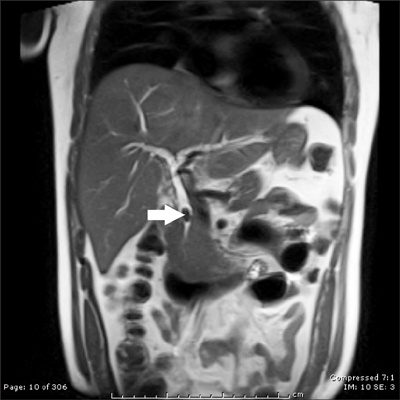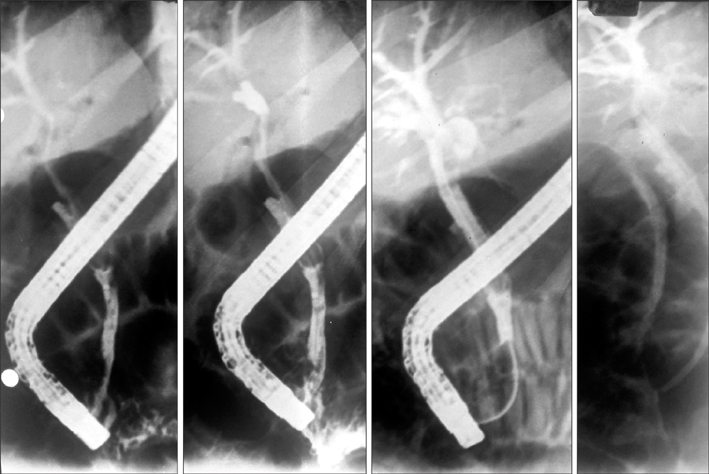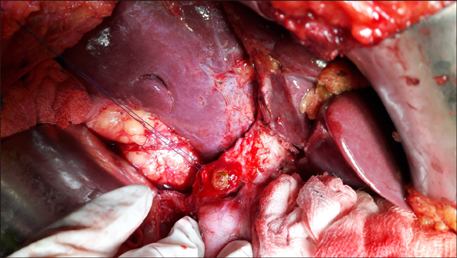Ann Hepatobiliary Pancreat Surg.
2017 May;21(2):88-92. 10.14701/ahbps.2017.21.2.88.
Hemobilia due to arteriobiliary fistula complicating ERCP for residual bile duct stone in a case of Mirizzi syndrome
- Affiliations
-
- 1Department of HBP and Liver Transplant, SevenHills Hospital and Health City, Mumbai, India.
- 2Department of General and Laparoscopic Surgery, SevenHills Hospital and Health City, Mumbai, India. drvinaythapar@hotmail.com
- 3Department of Gastroenterology, SevenHills Hospital and Health City, Mumbai, India.
- KMID: 2379107
- DOI: http://doi.org/10.14701/ahbps.2017.21.2.88
Abstract
- Hemobilia is a rare cause of upper gastrointestinal tract bleeding. Most cases are iatrogenic following medical interventions, most commonly liver biopsy and transhepatic cholangiography. We present a case of arteriobiliary fistula between the right hepatic artery and the common hepatic duct, in a case of Mirrizi syndrome, following endoscopic biliary stenting and presenting with hemobilia. The patient was treated by surgical disconnection of the fistula, ligation of the right hepatic artery, and bilioenteric anastomosis.
MeSH Terms
Figure
Reference
-
1. Baillie J. Hemobilia. Gastroenterol Hepatol (N Y). 2012; 8:270–272.2. Nam JG, Seo YW, Hwang JC, Weon YC, Kang BS, Bang SJ, et al. Massive hemobilia due to hepatic arteriobiliary fistula during endoscopic retrograde cholangiopancreatography: an extremely rare guidewire-related complication. J Korean Soc Radiol. 2015; 72:348–351.3. El Bouhaddouti H, Mazin K, Bouassria A, Mouaqit O, Benjelloun E, Ousadden A, et al. Hemobilia due to an iatrogenic arteriobiliary fistula complicating laparoscopic cholecystectomy: a case report. Open J Gastroenterol. 2014; 4:275–278.4. Lin SZ, Tseng CW, Chen CC. Hepatic artery pseudoaneurysm presenting with Mirizzi syndrome and hemobilia. Clin Gastroenterol Hepatol. 2009; 7:e73.5. Lee YT, Lin H, Chen KY, Wu HS, Hwang MH, Yan SL. Life-threatening hemobilia caused by hepatic pseudoaneurysm after T-tube choledochostomy: report of a case. BMC Gastroenterol. 2010; 10:81.6. Kawakami H, Kuwatani M, Kudo T, Ehira N, Yamato H, Asaka M. Portobiliary fistula: unusual complication of wire-guided cannulation during endoscopic retrograde cholangiopancreatography. Endoscopy. 2011; 43:Suppl 2 UCTN. E98–E99.7. Lee SH, Hong SG, Lee KY, Park PK, Kim SD, Lee M, et al. Delayed severe hemobilia after endoscopic biliary plastic stent insertion. Clin Endosc. 2016; 49:303–307.
- Full Text Links
- Actions
-
Cited
- CITED
-
- Close
- Share
- Similar articles
-
- A large common bile duct stone migrated from the gallbladder through a cholecystohepaticodochal fistula: an unusual complication of Mirizzi syndrome type II
- Massive Hemobilia due to Hepatic Arteriobiliary Fistula during Endoscopic Retrograde Cholangiopancreatography: An Extremely Rare Guidewire-Related Complication
- Successful Treatment of an Iatrogenic Hepatic Arteriobiliary Fistula with an Endobiliary Covered Stent Graft: A Case Report
- A Case of Mirizzi Syndrome with Cholecystocholedochal Fistula
- Mirizzi syndrome: one case report







